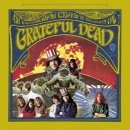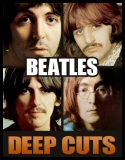Music Home / Entertainment Channel / Bullz-Eye Home
 Buy your copy from Amazon.com
Buy your copy from Amazon.com
| The Grateful Dead: The Grateful Dead Released: 1967 |
Released in May of 1967, the Grateful Dead’s first album sounds dated in some ways, but remains a vibrant time capsule of a key era in American music history. The band has never been known for its studio work, where it was difficult to conjure the improvisational magic of its legendary live shows. The fact that Warner Brothers insisted the band shorten four of this album's songs didn’t help, either.
Still, there’s an intangible energy at work on the debut album (which they recorded in just three days). This lends an immediacy that captures some of the live feel of what was coming to be known as “the San Francisco sound.” One only wishes there was “fly-on-the-wall” video footage of the recording process, such as rhythm guitarist Bob Weir telling producer Dave Hassinger he wanted to capture the sound of “thick air.”
There are actually only two original songs on the album, including leadoff track “The Golden Road (To Unlimited Devotion).” With its utopian lyrical vibe and ensemble vocals, the song captures the freewheeling spiritual magic of San Francisco in the ‘60s before the scene started to implode upon itself – “Well everybody’s dancing in a ring around the sun / Nobody’s finished, we ain’t even begun / So take off your shoes, child, and take off your hat / Try on your wings and find out where it’s at / Hey hey, hey, come right away / Come and join the party every day.”
The band would drop the song from the repertoire by 1970 and it wouldn’t be revived until bassist Phil Lesh renewed almost the entire GD catalogue with his band in 2000. But the upbeat rocker has become a fan favorite once again and remains an enduring symbol of the Haight-Ashbury scene’s spiritual peak.
But several songs from the album remained staples of the Dead’s repertoire for three decades. Jesse Fuller’s “Beat It on Down the Line” is a high-energy rave-up from Weir and features a classic ‘60s organ sound that is prevalent throughout the album. In latter years, this was a tune that Weir would only break out about once a tour to signal that it was going to be a particularly hot night.
Keyboardist and blues master Ron “Pigpen” McKernan steps out on Sonny Boy Williamson’s “Good Morning Little Schoolgirl,” a down and dirty blues number that remained a GD staple until the hard-drinking McKernan succumbed to liver failure in 1972. McKernan sounds like the old soul that he was here, and delivers some sharp harmonica work as well. The tempo picks up toward the end as Pigpen scats while the band starts jamming out in its trademark way, with Lesh and drummer Bill Kreutzmann driving the jam.
Jerry Garcia takes the lead vocal on “Cold Rain and Snow,” a tune that never left the band's repertoire. The song tapped into Garcia’s turbulent love life, both past and future – “Well I married me a wife / She’s been trouble all my life / Run me out in the cold, rain and snow.”
“Sittin’ on Top of the World” is a blues standard, but altered by the band’s electrified boogie-woogie arrangement. Garcia rips off some lightning quick leads that demonstrate his virtuoso skills and he and Lesh engage in some scintillating interplay that is just starting to really heat up at the two- minute mark when the song fades out. Another Garcia original, “Cream Puff War,” follows, a song that sounds somewhat similar to “Cold Rain and Snow” and didn’t last long in the live set.
The opposite is true for the epic “Morning Dew,” an apocalyptic folk song by Canadian Bonnie Rose about the insanity of nuclear war that had also been covered by Fred Neil and Tim Rose. But Garcia made the song his own with a poignant vocal and a crescendoing jam, an epic arrangement that would remain a GD standard until Garcia’s untimely departure from the planet in 1995.
“New, New Minglewood Blues” features Weir ironically singing about drinking whiskey and “stealing other womens from their men.” Like “Morning Dew,” the up-tempo jam would remain a GD staple until the very end.
The album ends with a 10-minute rave-up on the Noah Lewis blues standard “Viola Lee Blues.” In his 2005 autobiography Searching for the Sound, bassist Phil Lesh would write that “Viola Lee Blues” was the only song on the album that captured the band’s sound at the time. The song demonstrates the band’s ability to take a very simple chord progression and use it as a launch pad toward some incendiary jamming.
Garcia delivers some smoking leads and the band also demonstrates its burgeoning vocal harmonies. Lesh’s unique lead bass style is also at work, a key factor in how the band was able to keep three-chord jams interesting. It’s around the five-minute mark that the jam starts to really take off and approximate what the band did in a live setting. The jam reaches a superlative peak at about the 8:50 mark before dropping back into the song.
The Grateful Dead is far from the band’s most polished work, and beginners would do better to start off with one of the band’s many live releases from the 1970s. But for anyone with a strong interest in the rock history of the 1960s and the origins of the San Francisco sociocultural revolution, this album is an essential piece of the puzzle.
~Greg M. Schwartz






